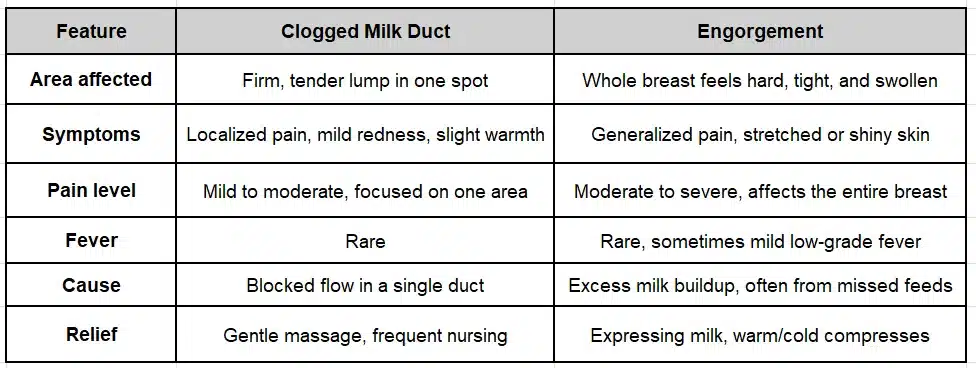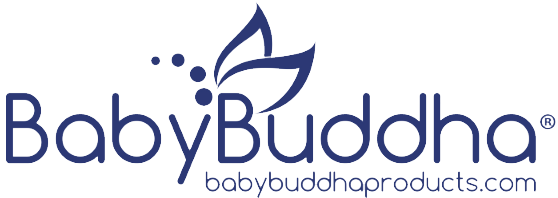Clogged Milk Ducts What Every Mom Should Know

It’s late at night, and you finally sit down to feed your baby when you feel a hard, tender lump in your breast. Every latch stings, and the ache lingers even after the session ends. This is what many mothers experience with a clogged milk duct. It’s a common breastfeeding challenge that can appear after a missed feed, a longer stretch of sleep, or even something as simple as wearing a tight bra.
While a clog can be painful and frustrating, the good news is that it’s usually temporary and easy to manage with gentle care. In this guide, you’ll learn what causes clogged ducts, how to ease the discomfort without making things worse, and how to prevent them from coming back.
Key Takeaways:
- A clogged duct feels like a sore, firm lump in the breast.
- It can be caused by missed feeds, tight bras, or milk not draining fully.
- Common symptoms include pain, redness, and slower milk flow.
- Try the B.A.I.T. method: Breast rest, Advil, Ice, and Tylenol.
- Call your doctor if symptoms last over 48 hours or you develop a fever.
What Is a Clogged Milk Duct?
A clogged milk duct, sometimes called a plugged or blocked duct, happens when milk can’t flow freely through one of the channels in your breast. This creates a tender, sometimes painful lump that makes feeding or pumping uncomfortable.
Why It Happens?
Milk ducts are tiny pathways that carry milk from the mammary glands to the nipple. When milk doesn’t drain fully, or when there’s added pressure on the breast (from a tight bra, certain sleeping positions, or even carrying a baby in one arm for long stretches), a duct can become narrowed or inflamed. This can cause milk to back up, leading to swelling, redness, and soreness in that area.
Signs You Might Have a Clogged Milk Duct

When milk flow slows inside the breast, it often shows up as noticeable changes you can feel or see. Understanding these signs early can help you act before discomfort worsens.
Physical Changes You’ll Notice
A clogged milk duct can show up in a few noticeable ways:
- A tender, firm lump or knot in one area of the breast that feels sore to touch.
- Pain or aching during milk letdown, which may improve slightly after feeding or pumping.
- Redness and warmth on the skin over the lump, sometimes with mild swelling.
- A “wedge-shaped” area of firmness, pointing toward the nipple.
- Temporary reduction in milk flow from the affected breast until the clog clears.
What Is a Milk Bleb?
Sometimes, a clog forms right at the nipple’s surface as a small milk bleb (also called a milk blister). It looks like a tiny white or yellow dot on the nipple tip, but it can cause surprisingly sharp pain and irritation. A bleb happens when thickened milk or a bit of debris blocks the opening of a duct, making it harder for milk to flow and, if left alone, it can lead to further clogging.
If the pain feels different than usual or isn’t easing, it’s natural to wonder if it’s more than just a clog.
Could It Be Something Other Than a Clogged Milk Duct?

Not all breast pain or swelling comes from a clogged duct. Sometimes what feels like a clog could be general fullness (engorgement) or, in some cases, an early infection like mastitis. Knowing what sets them apart can help you take the right next steps.
How to Tell a Clog from Engorgement
While both can be uncomfortable, their patterns and symptoms differ:

Clogged ducts feel like a knot or pebble under the skin, while engorgement makes the entire breast feel overly full and tight.
When Symptoms Hint at Mastitis
A clog that doesn’t clear can lead to inflammation or infection (mastitis). You may notice:
- Fever of 101°F (38.3°C) or higher
- Flu-like symptoms like chills, fatigue, or body aches
- Redness spreading beyond the lump or visible red streaks
- Severe pain and swelling that doesn’t ease after feeding or pumping
If these symptoms appear, contact your healthcare provider right away to prevent complications.
When a Lump Needs a Closer Look
Sometimes, what starts as a clog or mastitis can turn into something that needs medical attention. If symptoms worsen or a lump feels unusual, it’s worth getting checked. In rare cases, it could be:
- A breast abscess: A painful pocket of pus caused by an untreated infection, often requiring medical drainage.
- A galactocele: A smooth, milk-filled cyst that’s usually painless but still needs evaluation.
If something doesn’t feel right, trust your instincts and call your provider. Your peace of mind matters as much as your comfort.
Why Clogged Ducts Develop?

Once you know how to recognize a clog, it helps to understand what’s causing it. A clogged milk duct often has simple triggers like missed feeds, pressure on the breast, or changes in your routine that slow milk flow and allow it to build up.
1. Longer Gaps Between Feeds
If your baby sleeps longer than usual or skips a feeding, milk can back up in the breast. These longer stretches are often a normal part of your baby’s changing routine, but they can make clogs more likely if the breast isn’t emptied regularly.
2. When Milk Doesn’t Fully Drain
A shallow latch, tongue-tie, or a distracted baby who doesn’t nurse for long can leave milk behind. Even a rushed pumping session can help because if milk isn’t fully removed, it can build up and block a duct.
3. Tight Bras or Pressure Points
Underwire bras, snug tops, or even the strap of a diaper bag pressing against your chest can put pressure on your ducts and slow the natural flow of milk.
4. Sudden Changes in Routine
Starting solids, weaning, going back to work, or traveling can all affect your feeding schedule. These changes sometimes catch your body off guard, leading to milk pooling and clogs.
5. Thick or “Sticky” Milk
Occasionally, milk itself thickens in certain areas, making it harder to flow freely and creating a small blockage.
6. Oversupply of Milk
When you’re producing more milk than your baby needs, the breast can become overly full. Without frequent feeding or pumping, this fullness can lead to clogs.
7. Fatigue and Stress
It’s not just physical factors your body responds to exhaustion and stress, too. Both can slow your letdown reflex, which may make it harder for milk to drain completely.
Gentle Relief Steps for the First 24-48 Hours
Those first 24 to 48 hours after discovering a clogged milk duct can feel uncomfortable and even stressful. But with gentle care, most clogs start to improve quickly. The B.A.I.T. method: Breast Rest, Anti-inflammatories, Ice, and Tylenol offers a simple, nurturing way to ease pain, reduce swelling, and help your breast heal while you continue to feed your baby safely.
The B.A.I.T. Method
- Breast Rest: Think of this as giving your breast a moment to recover. There’s no need to forcefully empty it with extra pumping or aggressive feeding. Instead, feed your baby on demand and, if one breast is especially sore, start on the more comfortable side for a day or so.
- Advil (Anti-inflammatories): Pain and inflammation can take an emotional toll, especially when you’re already tired. Over-the-counter anti-inflammatories like ibuprofen (e.g., 600 mg every 6-8 hours for up to 48 hours) can help you stay comfortable. Always double-check the correct dosage with your healthcare provider.
- Ice (Cold Compresses): Cold compresses are soothing and help bring down swelling. Apply a cold pack or wrap ice in a soft cloth for 10–20 minutes every 1–2 hours while awake. Many mothers find this cooling relief far gentler than the old advice of warm compresses early on.
- Tylenol (Acetaminophen): If pain is still bothering you, acetaminophen (every 6-8 hours) can be safely paired with ibuprofen. Please take the dosage as prescribed by your provider.
Extra Comfort Tips That Help
- Breastfeeding or Pumping Gently: Continue feeding or pumping every 2–3 hours, but avoid overdoing it. Starting on the affected side and switching feeding positions, like pointing your baby’s chin toward the lump, can help milk drain more completely without adding pressure.
- Gentle Massage and Lymphatic Drainage: Use light “sweeping” strokes toward the nipple or soft upward motions toward your armpit and collarbone to reduce swelling. Firm, hard massage can actually make inflammation worse, so keep it light and slow.
- Rest, Hydration, and Nutrition: Your body is already working hard. Take breaks when you can, drink plenty of water, and eat nourishing meals to give yourself the energy to heal. Even short naps and quiet moments can make a difference.
- Consider Probiotics: If clogs keep coming back, some parents find relief with probiotics like Lactobacillus fermentum or Lactobacillus salivarius. These may help reduce inflammation and support healing. Check in with your provider to see if they’re right for you.
- Keep an Eye on Symptoms: You know your body best. If the lump hasn’t improved after 48 hours, or if you notice fever, chills, or spreading redness, reach out to your healthcare provider. Early help can prevent things from getting worse.
Final Thoughts
A clogged milk duct can be both painful and emotionally draining, especially when you’re already giving so much to care for your baby. With the right support, most clogs clear within a few days, and your body continues to provide what your baby needs.
If you experience frequent clogs, your healthcare provider or lactation consultant may also suggest trying supplements like lecithin, which can sometimes help improve milk flow and reduce blockages. Always check with your provider before adding anything new to your routine.
Most importantly, be kind to yourself. Needing extra help or rest doesn’t mean you’re not doing enough. It means you’re listening to your body.
You’re doing an incredible job, even on the hard days.
FAQs
1. How can I tell if it’s a clogged milk duct or mastitis?
A clogged duct usually causes a sore, firm lump with some redness and tenderness, but no fever. Mastitis often starts with similar symptoms but adds chills, flu-like fatigue, and a fever over 101°F (38.3°C). If you feel suddenly unwell or the redness is spreading, check in with your provider.
2. Should I keep breastfeeding if I have a clogged milk duct?
Yes, it’s usually safe and helpful to keep nursing. Regular feeding or pumping helps clear the blockage and prevents more buildup. Start on the affected side if it’s not too painful, and try adjusting positions to help drain different areas of the breast.
3. Can a clogged milk duct go away on its own?
Many clogs do clear with rest, frequent feeding, and gentle care. Using the B.A.I.T. method (Breast rest, Advil, Ice, Tylenol), staying hydrated, and applying light massage often helps the lump resolve within a couple of days.
4. What causes clogged ducts in the first place?
Clogs often occur when milk doesn’t drain fully. This can be due to long gaps between feeds, tight bras, a shallow latch, oversupply, or just plain exhaustion. Sometimes, a small bleb (a blocked nipple pore) can also back things up.
5. How do I stop clogs from coming back?
A consistent feeding or pumping routine, comfortable bras, and good latch support can help. Some parents also find that taking sunflower lecithin or probiotics (with provider guidance) helps reduce how often clogs happen.










